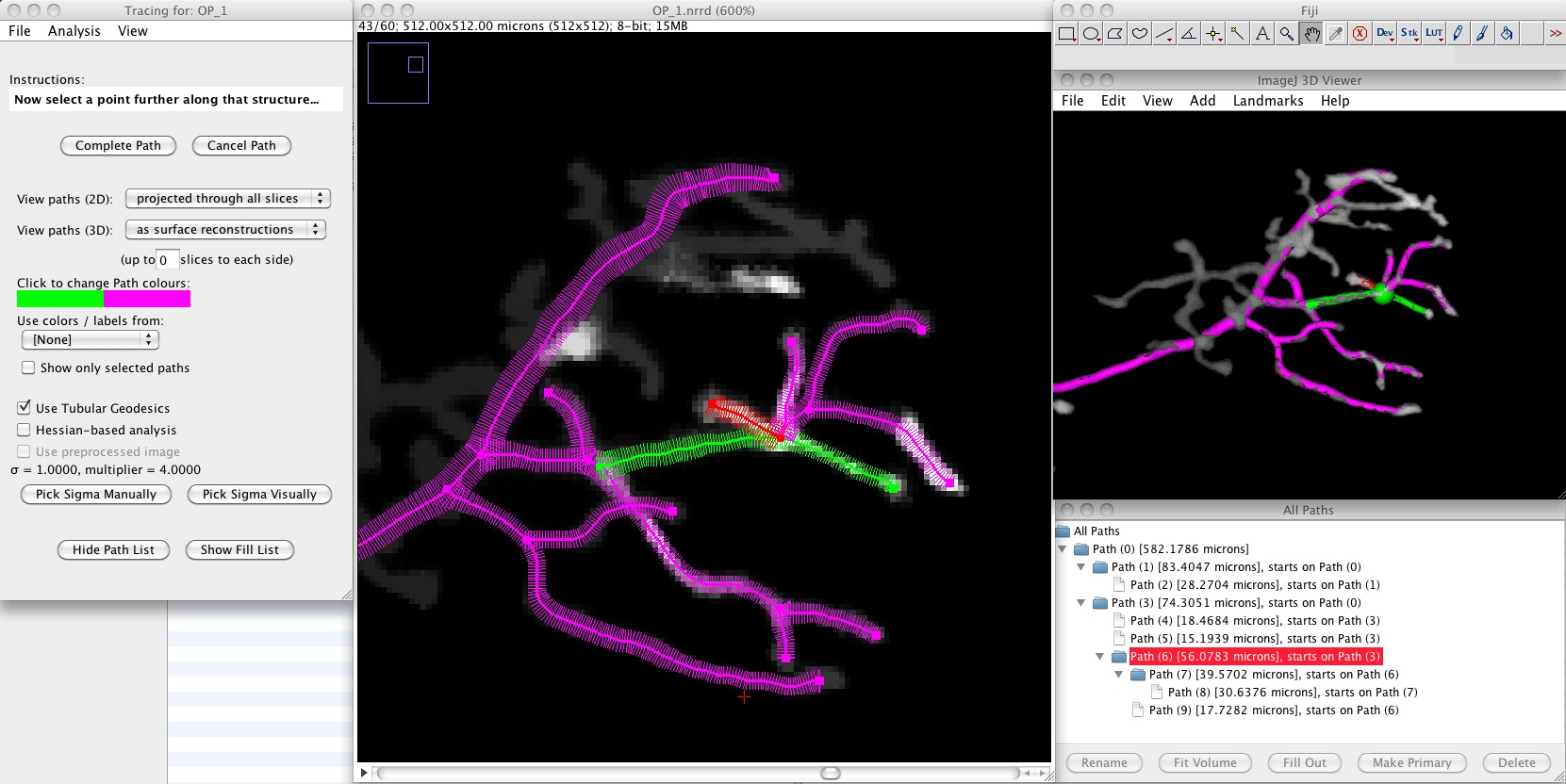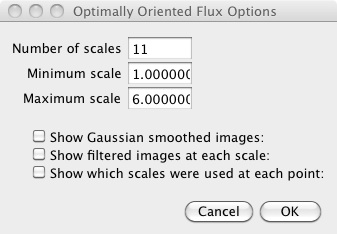Semi-Automated Tracing of Tubular Structures: a Fiji Plugin
This plugin extends the Simple Neurite Tracer (SNT). SNT uses the A* algorithm to link user provided points and extracts pixelic centerline points without radius estimates. The proposed plugin uses the Fast Marching Algorithm instead, and outputs smooth sub-pixelic tubular paths (see figure).

Download
Prebuilt binaries are available for the following architectures:
- Linux 64-bits up-to-date
- Linux 32-bits
- MacOS Lion 64-bits
- MacOS Snow Leopard 64-bits up-to-date
- Windows: coming soon.
The source code is publically available on github, here.
Installation
- The tracing software in embedded into the SNT plugin. It can be activated by selecting the “Use Tubular Geodesics” option on the SNT main window.
- To get this functionality, first download the latest version of Fiji and update it.
- Download the zipped plugins file from the above “Plugins” section and unzip it.
- Copy the two jar files to your Fiji’ plugins directory.
How to use
- The input is expected to be a 3D image encapsulated in a well known file format such as tiff or nrrd.
- A preprocessing step is needed to drive the semi-automatic tracing. This step generates a scale-space tubularity measure that is saved in a file.
- Preprocessing:
- Once the image is loaded, go to plugins->”Multi-Scale Oriented Flux Tubularity Measure”. You will get the following window:

- Set the number of scales and the min/max scales. The scale corresponds to the radius of the tubular structure in physical world coordinates, Min/Max scales define the range of scales to operate on. You will never get a tubular structure with a radius smaller (larger) than the minimum (maximum) scale.
- Once you click on “OK”, you’ll be asked to provide a filename for the tubularity measure. If the input image filename is Image.ext, “ext” being the extension of the image (tiff / nrrd … etc ), the tubularity measure should be written in the same location and should have the following filename Image.oof.nrrd .
- If your input image is large, you may need to run this pre-processing step on a powerful computer. On a powerful server, and for a 3D image containing ~ 100 million voxels, the pre-processing does not take more than 10 minutes for 12 scales. This pre-processing step can be run overnight for many images using jython scripting.
- Once the image is loaded, go to plugins->”Multi-Scale Oriented Flux Tubularity Measure”. You will get the following window:
- Tracing :
- Once the tubularity measure generated, you can start tracing with SNT. You need to activate the “Use Tubular Geodesics” option. To get familiar with the SNT interface, we highly recommend to view some of the SNT tutorials.
References
Please note that the publication lists from Infoscience integrated into the EPFL website, lab or people pages are frozen following the launch of the new version of platform. The owners of these pages are invited to recreate their publication list from Infoscience. For any assistance, please consult the Infoscience help or contact support.
Automated Reconstruction of Tree Structures using Path Classifiers and Mixed Integer Programming
2012. IEEE Conference on Computer Vision and Pattern Recognition (CVPR), Providence, Rhode Island, June 16-21, 2012. p. 566-573. DOI : 10.1109/CVPR.2012.6247722.Please note that the publication lists from Infoscience integrated into the EPFL website, lab or people pages are frozen following the launch of the new version of platform. The owners of these pages are invited to recreate their publication list from Infoscience. For any assistance, please consult the Infoscience help or contact support.
Tubular Geodesics using Oriented Flux: An ITK Implementation
Insight Journal. 2013.This software implements a simplified version (Isotropic) of the method proposed in:
- Tubular Structure Segmentation based on Minimal Path Method and Anisotropic Enhancement. Fethallah Benmansour and Laurent D. Cohen IJCV, Volume 92, Number 2 (2011), 192-210.
Contact
Please mail delin@epfl.ch for bug reports, comments and questions.